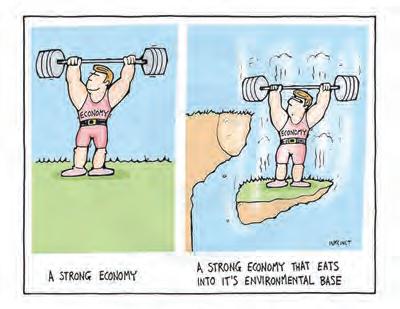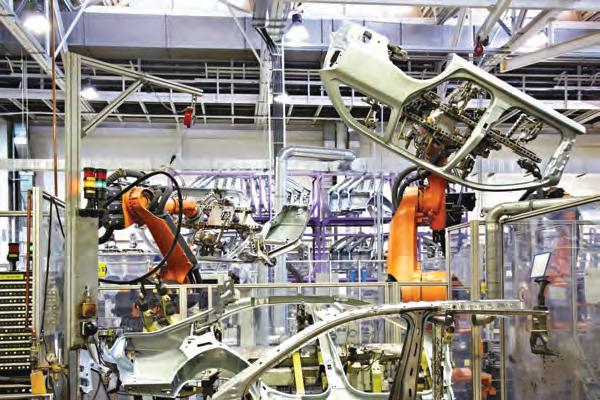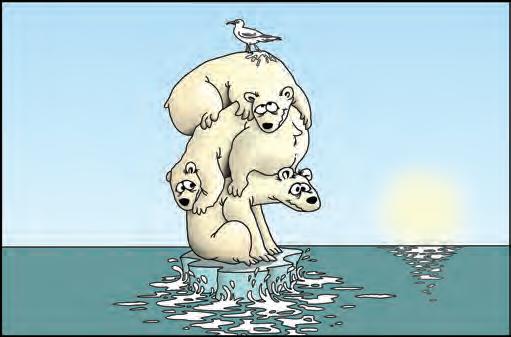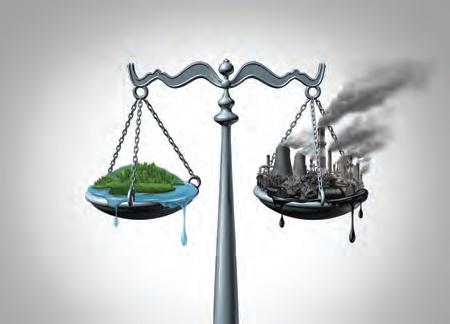
14 minute read
4.13 The potential costs of economic growth
growth, with government policies to reduce income inequality accounting for the remaining one-third. For many people, economic growth has meant increased life expectancy, better healthcare, and improved education and literacy — elements essential for better living standards.
FIGURE 4.25 Strong economic growth at rates higher than rises in Australia’s population increase average per capita production and incomes, while slower growth rates tend to reduce average per capital production and incomes and therefore material living standards. 72 000 71659 71436 71686 70 000 68 000 66 000 2007–08 2008–09 2009–10 2010–11 2011–12 2012–13 2013–14 2014–15 2015–16 2016–17 2017–18 2018–18 2019–20 2020–21 2021–22 2022–23 2023–24 2024–25
Advertisement
72440 74109 74690 75909 75388 76870 77335 78713
78322
77518Average real GDP per capita (A$) 78245
Australia’s average real GDP per capita (A$) 74 000 76 000 78 000 80 000 82 000 A rise in real GDP per capita means that because more goods and services have been produced, more incomes are generated allowing for greater purchasing are generated and material living standards 84 000 Source: Data derived from ABS, National income, expenditure and product, Table 1, Key national aggregates, see https://www.abs. gov.au/statistics/economy/national-accounts/australian-system-national-accounts/latest-release. 4.12.3 Strong economic growth improves the government’s finances and its capacity to provide services and welfare Another benefit of a strongly growing economy is that there should be an increase in average incomes, with fewer people unemployed. This also means that there will normally be a rise in the amount of revenue collected by the federal government from personal income and other types of tax (such as that collected from company profits, and from the goods and services tax), along with reduced numbers receiving unemployment benefits. This strengthens the government’s finances and budget position and is ultimately beneficial for our material living standards. For example: • The extra government revenue generated from economic growth can be used to better help the neediest individuals in our society through the payment of more generous cash welfare benefits (e.g. to the unemployed, families, sick, aged and veterans), allowing these people to enjoy reasonable living standards. There is more cash to go round for those needing help, and the welfare system is financially more sustainable, without adding further to government debt. • The extra tax money can also be used by the government to provide better quality, cheap or free community UNCORRECTED PAGE PROOFS services through the public sector (e.g. public health, education, transport and housing). By contrast, if economic growth is weak, supporting the incomes of the neediest individuals or providing community services becomes even less affordable for the government, and living standards tend to fall.
The number of people living in extreme poverty — including projections to 2030
1.9 billion people lived in extreme poverty in 1990 (36% of the world population) 1.9 billion
1990
730 million in 2015 (9.9% of the world population) 650 million in 2018 500 million 479 million in 2018 1 billion 1.5 billion 1995 2000 Sub-Saharan Africa East Asia and Pacific South Asia 2005 2010 2015 2020 Projection by the World Bank 2025 2030 Middle East and North Africa Latin America and the Caribbean Other high income Europe and Central Asia 4.15.4 Strong economic growth can improve non-material living standards Economic growth can sometimes help improve our non-material living standards and the quality of our daily lives. First, think for a moment about the massive non-material benefits Australians enjoy, largely thanks to decades of quite strong economic growth. • By sacrificing some income not needed for satisfying pressing needs, individuals have the possibility of gaining more leisure time and reducing their hours of work. • We have an increased ability to enrich our lives and minds through the broadening experiences gained from international travel. • We have the resources and capacity to tackle environmental problems that currently reduce our wellbeing. • There is the opportunity to extend life expectancy and improve our quality of life through improved health possibilities, care, and nutrition. • Society can use technology and innovation to eliminate many physically demanding or boring jobs that reduce work satisfaction. UNCORRECTED PAGE PROOFS • There is an improved capacity to allocate resources towards the arts, education, music, and drama — experiences that can enrich our lives and expand our possibilities Second, strong economic growth normally tends to reduce the number of persons unemployed and those in poverty. For instance, in February 2022 when economic activity was strong, there were only 563 000 unemployed, whereas in July 2020 at the end of the recession, the number was 1 009 000, due to COVID-19
lockdowns and supply chain issues. Sadly, studies reveal some of the devastating effects of unemployment on the non-material living wellbeing of individuals and society generally. For instance: • Both the physical and mental health outcomes of the unemployed are far worse than the outcomes of those with paid jobs. • More unemployed individuals experience feelings of failure, social isolation, and lack of self-worth. • Unemployment causes family financial and other stress, breakups, and unhappiness. • Both the ABS and the NSW Bureau of Crime Statistics have reported higher youth crime rates among
Australia’s long-term unemployed, those who leave school early and people on low incomes and in poverty. These problems that undermineour non-material living standards tend to be less severe when there is stronger economic growth and jobs are easier to find.
Resourceseses Resources to come 4.12 Activities
Students, these questions are even better in jacPLUS
Receive immediate feedback and access sample responses Access additional questions
Track your results and progress Find all this and MORE in jacPLUS 4.12 Quick quiz 4.12 Exercise 4.12 ExerciseUNCORRECTED PAGE PROOFS 1. Before answering the questions that follow, examine figure 4.27 showing the annual percentage change in
Australia’s rate of economic growth using real GDP.
FIGURE 4.27 Changes in Australia’s rate of economic growth
Annual percentage change in the value of 5 Rate of economic growth (year ended June, percentage change in chain volume GDP, reference year 2019–20)
4.5
2 1.5 0.5 0 2015–16
4 chain volume GDP 2.5 3 3.5 2.7 2.3 2016–17 2017–18 2018–19 2019–20 2020–21 2021–22 2022–23 2023–24
2.9 2.1 0.0
1.5 Source: Data derived from ABS, National income, see https://www.abs.gov.au/statistics/economy/national-accounts/ australian-system-national-accounts/latest-release. a. Explain the general type of relationship that exists between Australia’s rate of economic growth and the rate of unemployment. (2 marks) b. Referring to figure 4.22, predict the years when Australia’s unemployment rate was probably relatively low. Justify your selection. (2 marks) c. Explain how a lower unemployment rate would be likely to affect society’s non-material living standards. (2 marks) d. Given slower rates of economic growth in 2019–20, explain how you would expect this to affect the Australian government’s financial situation and its ability to provide better services like transport, education and welfare systems. (2 marks) 2. Again, referring to figure 4.27: a. Explain the general type of relationship that exists between Australia’s rate of economic growth and the level of average incomes per person. (2 marks) b. Predict the years when the rate of rise in Australia’s average income per person was probably relatively fast. Justify your selection. (2 marks) c. How might a faster rise in average incomes per person be likely to affect material living standards? (2 marks) 3. Again, referring to figure 4.27: a. Explain the general type of relationship that exists between Australia’s rate of economic growth and the state of the Australian government’s financial position or budget (i.e. the difference in value between total taxes and government outlays). (2 marks) b. Referring to figure 4.27, predict the years when the financial position of the Australian government is likely to be strongest. Justify your selection. (2 marks) 4. Sometimes, rapid economic growth can lead to an improvement in society’s non-material living standards. Identify and outline two ways this might happen. (2 marks) Fully worked solutions and sample responses are available in your digital formats. 1 UNCORRECTED PAGE PROOFS
KEY KNOWLEDGE
• the potential costs of economic growth, including boom and bust economic cycles, congestion and pollution, environmental damage, potentially widening inequality and ‘affluenza’
Source: VCE Economics Study Design (2023–2027) extracts © VCAA; reproduced by permission.
Few people, especially those in low-income countries, deny the benefits of strong economic growth for general improvements in living standards. Worldwide, and in the space of just two decades, growth has lifted perhaps 1 billion people out of severe poverty by helping to generate jobs, raise incomes, and allow for a greater satisfaction of basic needs (like food, clean water, accommodation, clothing and medical services) FPO and even some wants. However, the question that we must now ask is — at what costs have we pursued economic growth? The main ideas are summarised in figure 4.28.
FIGURE 4.28 Some potential costs of economic growth Potential costs of rapid economic growth Economic costs:
Higher rates of structural unemployment Possible rise in the inflation rate
Slower future rates of economic growth Environmental costs: Increased CO2 emissions and climate change Deterioration of common access resources Depletion of non-renewable natural resources Increased noise and congestion More social inequality

Social costs: Reduced leisure time Under-parenting of children Increased stress and health issues 4.13.1 The economic costs of economic growth While strong economic growth brings benefits, especially in the short-term, it also creates economic problems and comes with at least three important costs. • Rapid economic growth is unsustainable and will limit future economic growth Given the world’s finite resources, strong economic growth today is likely to limit the future rate of economic growth. This is because increasing GDP normally requires access to additional natural and other resources. Unfortunately, our natural resources like clean water and air are limited. In addition, as a consequence of using up non-renewable natural resources like minerals to fuel greater production for the current generation, this is reducing the capacity of future generations and an ever-growing global UNCORRECTED PAGE PROOFS population to enjoy economic prosperity. This raises the question — how long will the world’s natural resources last? While estimates exist for many key minerals, the answer is uncertain. It depends on assumptions including new discoveries of mineral wealth, our ability to substitute one mineral or energy
resource for another by using fresh technology, the rate of population growth, and our ability to move towards a circular economy (i.e. instead of extracting minerals and producing goods with a short life expectancy to consume and then throw away, raw materials can be recycled and reused, slowing the demand and depletion of some resources). • Excessively strong economic growth can accelerate inflation
When economic growth is driven by strong rises in spending or AD, and the economy is close to its productive capacity or on its PPF, it is common to see a rise in the prices paid for consumer goods and services. Here, inflation is due to the onset of widespread shortages where demand or spending exceeds supply or production. In turn, higher inflation has a negative effect. It reduces the purchasing power of money, eroding consumption and hence material living standards. • Economic growth can add to structural unemployment Usually, rapid economic growth causes a fall in cyclical unemployment (i.e. unemployment that exists in a recession due to a lack of spending or AD) because as businesses seek to expand production, they need to purchase extra resources including labour. However, sometimes economic growth involves structural changes to the way firms produce goods and services and the type of things that are made in the economy. When firms change their production methods and use new technology to become more efficient (such as using robots on an assembly line, ATMs for banking, automated warehouses, online shopping and so on), especially in the short-term, this can cause some workers to lose their jobs, resulting in higher structural unemployment even though these changes can accelerate economic growth in the longer-term. Additionally, in seeking to be more competitive and expand, some firms undertake cost-cutting measures. This can involve closing down less efficient and unprofitable business operations, or even relocating the whole business to low-wage countries (e.g. Bonds underwear, Brinton’s carpets and aircraft servicing moved to China, and customer call centres shifted to India). While adding to global economic growth, this too can cause structural unemployment at home. 4.13.2 The environmental costs of economic growth Economic growth can accelerate environmental problems including climate change and the deterioration in the quality of common access goods (i.e. those things we all share and depend on, like the air we breathe, oceans, UNCORRECTED PAGE PROOFS fish stocks, climate, forests, rivers, and ecosystems). In addition, economic growth, urban expansion, increased urban noise, and overcrowding also go hand in hand with increasing GDP.

Economic growth causes a deterioration of common access resources

Common access resources are needed for survival. They are seen as free and non-excludable (that is, anyone can use them without paying for them), so without proper safeguards imposed by nations (e.g. environmental pollution controls, or putting a price or cost on pollution to make it less attractive), these resources are often over-exploited for personal gain or profit. Abuse by individuals can deprive others of consumption. The atmosphere is a common access resource. So, when pollution is released into the air (or waterways) as a result of production, consumption and waste disposal, this creates negative externalities or costs for third parties who are usually not directly involved with the particular economic activity — costs associated with rising sea levels, the destruction of island and coastal communities, severe weather events, health issues, the loss of life and, over time, reduced levels of GDP growth and economic prosperity. Economic growth accelerates climate change undermining living standards Much research now shows a close connection between rises in global GDP levels and climate change. This connection exists because the production or goods and services, and their consumption and disposal, generate greenhouse gasses that are released into the atmosphere. These cause global warming with far reaching negative externalities or costs, now and into the future. • Severe climatic events: Global warming is leading to more frequent and severe weather events including cyclones, storm surges, droughts, extreme temperatures, bushfires, and floods. • Rising sea levels: Global warming is melting the polar caps significantly increasing sea levels. This causes coastal erosion, damages property, and threatens coastal and island communities, adding to levels of climate-induced migration. • Climate change slows economic growth and GDP: For most countries, climate change is a less favourable aggregate supply factor that will continue to slow economic growth, GDP, incomes and living standards. For example, one estimate of the global cost of climate disasters for 2020 put the loss at $272 billion! Another report concluded that climate change would shave 11–14 per cent off global GDP by 2050, compared with no climate change. Modelling used in figure 4.29 shows the expected impact on counties’ GDPs of climate change by 2100. While northern countries stand to gain, most (including Australia) are likely to suffer. Of particular note is that those likely to suffer most are low-income nations that have contributed least to emissions and climate change. UNCORRECTED PAGE PROOFS They are the third party paying a disproportionate share of the costs. For Australia, apart from the significant loss of life and personal suffering, we think of the huge financial costs of recent fires, floods and droughts over the last five years resulting from reduced yields, repairs to

FIGURE 4.29 Projected change in GDP by 2100 from global warming against no climate change — losers and winners
Permission clearance pending

infrastructure, houses and businesses, and insurance payouts. For us, these disasters are expected to rise in severity and frequency at an annual cost estimated to be around $129 billion by the year 2100. The main takeaway here is that the impacts of accelerating climate change dramatically reduce the material and non-material gains or benefits derived from economic growth, and that it is time to take substantial action on climate change and realise that it can not be business as usual. • Food insecurity: Economic growth that has accelerated climate change has also tended to slow crop yields, despite advances in agriculture. With the number of mouths to feed in the world still rising, moving forward food security has become an even more significant issue. Volatile and generally higher commodity prices is likely to mean that in some years there will be less to eat, making life even more precarious. In addition, water security is a real problem in some countries. As highlighted by some, it is not a huge stretch to imagine that issues related to food and water security could lead to wars and conflict, and threats to world peace. • Degraded ecosystems: Climate change due to economic growth has undermined the sustainability and quality of ecosystems. It has led to the loss of biodiversity needed to maintain functions like providing oxygen, clean water, pollination, and pest controls that are needed for survival. • Health impacts: Climate change is negatively impacting global health. There are deaths because of heatwaves and air pollution (estimated by the WHO to be around 7 million per year). In addition, there are changed patterns of disease spread (e.g. malaria and dengue fever). UNCORRECTED PAGE PROOFS











